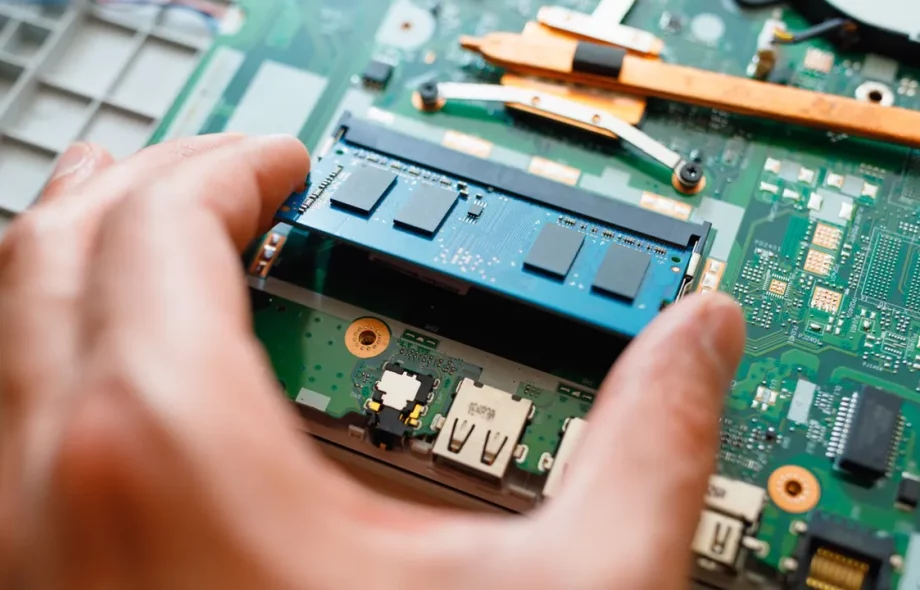RAM is the short-term memory in computers. It helps access data quickly when loading, opening apps, or switching tasks. It is crucial for multitasking, gaming, and complex software use. RAM is not permanent storage like SSDs or hard drives. Upgrading RAM can boost performance.
Visit Also: Laptop Repair Near Me
Why Upgrade Your Laptop RAM?
Check compatibility
Prior to upgrading the RAM in your laptop, you should first ensure compatibility. Some laptops cannot handle more RAM. You can check your laptop’s manual or manufacturer’s site. You can find out the maximum RAM size and type, such as DDR3 or DDR4, on the manufacturer’s website. The RAM speed (measured as MHz) must also match what the laptop motherboard can support. Incompatible RAM can cause system instability or boot failure.
Understanding Your Needs
Calculate how much RAM is needed based on the way you use your laptop. If you only use your laptop to do simple tasks, such as browsing the internet, creating documents or watching videos, then 8GB RAM is sufficient. A laptop with 16GB to 32GB RAM is recommended for those who enjoy video editing or virtual machines. Your system can handle more data with the help of more RAM. It will improve performance significantly when you are working with heavy applications.
Cost and Performance Gain: Consider the Cost vs.
It is not always economical to upgrade RAM in order to improve performance. Performance gains can be different depending on your current setup. Addition of more RAM is not necessary if you already have 16GB. This isn’t true unless your workload requires you to use a lot of memory. Compare RAM upgrades with other upgrades. Upgrades to processors and SSDs can boost performance. Consider the pros and cons of each upgrade.
Upgrade options
Some laptops have RAM that is soldered directly to the motherboard. It is impossible to upgrade. Some laptops only have one or two slots for modules. Check the manual of your laptop before buying new RAM. Notify us if slots are available or if RAM modules need to be upgraded.
How to upgrade your laptop’s RAM?
Check compatibility
Check your laptop’s model number. You can also check the manual or website of the manufacturer. Check the user manual or the manufacturer’s website to find out your laptop’s RAM type and capacity.
Prepare by Powering Down and Preparing
Remove the battery after shutting down your laptop. If your laptop has an internal battery, you can remove it by unplugging and turning off the laptop. Hold the power button down for 10 seconds in order to drain the remaining power.
Access to RAM Slots
-
Find the RAM compartment Turn the laptop upside down to locate the RAM compartment. This compartment is usually covered by a small screwed-on panel.
-
Remove panel: Use a screwdriver to remove the screws holding the panel in place. Lift the panel to reveal the RAM slots. Place the screws in an appropriate location. If your laptop does not have a RAM panel, you may need to remove the cover.
Remove Old RAM (If Needed)
If your laptop’s slots are full, you must remove any old RAM modules. The metal clips on either side of the module can be gently pushed away. The RAM module should be popped out in an angle. Holding the edges of the RAM module, you can carefully slide it out. Do not touch the connectors made of gold.
Installing New RAM
To ensure the correct orientation, take the new RAM module. Match the notch of the RAM to the notch of the slot. Insert the module at a 30 degree angle into the slot. Press down firmly on the module until it is fully seated. The metal clips will click into place.
Disassemble the Laptop
-
Replace panel: After removing the RAM access panel, align it and screw it in using the screws that you have saved. If you have removed the back cover in its entirety, align it carefully and snap it into place. Secure it with screws.
-
Replace the battery: If you have removed the battery from the slot, place it back in. When you press down, you will hear a clicking sound.
-
Connect power: Plug the power adapter into the laptop.
Test the Power On and Test
To upgrade your laptop’s RAM, first press the power button. Then, right-click and select “This PC” or “My Computer.” Check how much RAM is installed. Use a tool like “Windows Memory Diagnostic” to test it. If your laptop is running slowly, consider replacing it. Atdoorstep has a great range of new and refurbished laptops. They are all in excellent condition and come with a full warranty. To know more details about laptop repair in Dubai, call our toll-free number 045490505.
 :
https://www.pinterest.com/atdoorstepinuae/
:
https://www.pinterest.com/atdoorstepinuae/

